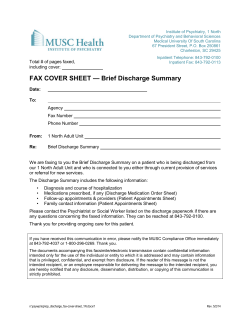
Urban discharge - SETAC Pellston workshop
SETAC Pellston workshop | 22-27 March 2015 | Parador El Saler, Valencia, Spain Simplifying environmental mixtures An aquatic exposure-based approach via exposure scenarios Society of Environmental Toxicology and Chemistry Urban Runoff Discharge Scenario Leaders: Dick De Zwart (RIVM, Netherlands), Derek Muir (Environment Canada, Canada) The urban scenario of mixture inputs to municipal surface waterbodies is mainly concerned with runoff from impervious surfaces. This also entails storm water overflows from combined and rainwater only sewer systems. As a consequence of this, various types of chemicals can be expected to occur in the resulting diffuse mixture exposure of receiving waters. Runoff from roads may contain petrochemicals (oil and grease) and PAHs from vehicle emissions, road salts, and all kinds of road, and tire wear products (e.g. suspended solids, black carbon, nanomaterials and heavy metals). In the structurally built environment, roofing, gutters and other structural objects may weather to release a variety of constituents: e.g. metal objects may leach heavy metals, wooden structures may leach wood preservatives and paint pigments, while plastic building materials may leach plasticizers and flame retardants. The use of weed killers and other pesticides in the green space (yards, gardens, fields, forest, boulevards, and parks) and paved urban areas may lead to the runoff discharge of a variety of agrochemicals. Although not the main topic of the urban scenario, the urban scenario also has to consider non treated or partially treated point sources from industrial origin, as well as diffuse inputs from dry and wet atmospheric deposition. In urban areas further discharges can be expected from excess water originating from storm events that may be released untreated from combined or separate rainwater sewer overflows (CSO & SSO). The diverse nature of all these sources of exposure makes it very hard to distinguish a generally applicable common denominator in the urban discharge scenario. Obvious is that urban discharge most likely relates to a number of socio-economic factors: 1) Human population density, 2) Economic status 3) Main economic activities (urban agriculture, commercial, industrial, service oriented), 4) Infrastructural quantity, and 5) Infrastructural quality (age, maintenance, technical design). Parallel to socio-economic factors, urban discharges are also strongly influenced by geographical factors: 6) Surface area, 7) Climate, 8) Terrain slope and soil permeability (runoff vs infiltration), and 9) Ratio open vs impervious area. All these factors can be taken into account by analyzing multiple layers of GIS information. Another aspect to consider is the flashy or short-lived nature of urban discharges, both in terms of quantity and chemical intensity. This is mainly due to the intermittent nature and seasonality of wet deposition and the variability of the buildup period between deposition episodes. In order to properly evaluate the urban discharge scenario, a strong input is needed from people experienced in the evaluation of urban hydrology. The urban scenario group has to focus on defining and prioritizing common denominators in the types and loading of chemicals that are determining urban runoff discharges and that can be predicted by quantification of socio-economic and geographical factors. The urban discharge scenario is the most difficult scenario to assess, as it requires an understanding of both pointsources and non-point sources within the urban context as well as, typically, receiving inputs from upstream contributions from sub-urban and rural (agriculture, smaller city inputs) sources. Urban areas often are located along bodies of water, as transportation of goods via shipping historically led to settlement and expansion. Storm water runoff, combined sewer overflows, wastewater treatment plants, increased presence of industry, hospitals, modified receiving waters (channelization, controlled erosion, low-head dams, etc) all result in unique chemical and water flow signatures that are quite different from the other scenarios. In the urban environment nearly all receiving waterbodies are highly human-modified. In many, mainly flat urban regions (e.g. NL), and in new suburban developments as well, waterbodies are even completely man made for the sole purpose of temporarily storing excess storm water. Ecological impact will definitely depend on the discharge flux and volume, the geometry of the discharge relative to the receiving waterbody, and the size of the receiving waterbody. In heavily modified waterbodies, it is not always simple to detect deviation from normal ecological structure, functioning and performance. In non human-dominated ecosystems the concept of recognized ecological/biological reference conditions is used as an anchor to detect ecological change. Estimating the ecological impact of urban discharge is often hampered by the absence of proper pristine reference conditions. There are a few options to derive suitable reference information; 1) It is always possible to find a minimally SETAC Europe vzw, Av. de la Toison d’Or 67, 1060 Brussels, Belgium T +32 2 772 72 81 | www.setac.org | setaceu@setac.org SETAC Pellston workshop | 22-27 March 2015 | Parador El Saler, Valencia, Spain Simplifying environmental mixtures An aquatic exposure-based approach via exposure scenarios Society of Environmental Toxicology and Chemistry disturbed site and define this as the local reference. 2) Biological target references can always be adopted by defining a suitable water typology based on physico-chemical habitat characteristics, and appointing a set of key species that should be present, and a set of key species that may not be present for each of these water types. 3) It may be possible to extract information on local reference conditions from historical biological census data collected when the urban waterways were less contaminated. The urban scenario group has to focus on determining ways to distinguish ecological impacted from nonimpacted conditions. Once ecological impact has been concluded, causation has to be analyzed by separating the ecological effects of habitat alterations, inappropriate flow conditions, salt intrusions, eutrophication, acidification processes, etcetera from the effects caused by mixture toxic stress. The answer of the ecosystem to all these types of perturbation is similar: CHANGE in ecological structure, functioning and/or performance. The game that has to be played in the attribution of observed impacts to underlying causation is called gradient analysis. For all the potential stress factors, this type of statistical analysis requires the gradients to be long (from low to high), more or less continuous (gradual) and independent. Generally, these requirements are impossible to be fully met simultaneously. Statistical power of attributing impacts to chemical loading will certainly improve by analyzing combined mixture toxic stress as a whole, as opposed to the individual components of the mixture. When measured or projected environmental concentrations of individual mixture constituents are available, it is possible to generate an overall toxic pressure of the mixture in terms of the proportion of exposed species that will suffer from intoxication (msPAF - multi substance potentially affected fraction of species). It has frequently been demonstrated that msPAF evaluations based on exceedance of acute L(E)C50 values most closely resemble ecological impacts that can be observed in the field. Applying these methods in a proper manner, regularly leads to an indication of ecological impacts with msPAF >5%. If msPAF >5%, this is regularly only caused by very few of the compounds in the environmental mixture. The problem is here that the nature of the top 5% of toxic chemicals is very site specific. The urban scenario group has to focus on defining methods to distinguish the impact of toxic chemical discharge from other urban related stress factors. SETAC Europe vzw, Av. de la Toison d’Or 67, 1060 Brussels, Belgium T +32 2 772 72 81 | www.setac.org | setaceu@setac.org SETAC Pellston workshop | 22-27 March 2015 | Parador El Saler, Valencia, Spain Simplifying environmental mixtures An aquatic exposure-based approach via exposure scenarios Society of Environmental Toxicology and Chemistry Additional discussion points Prospective o Site specific Desk study on attached processes Tracer studies possible? o Dilution factors – overall vs mixing zone o Chemistry o What proportion of urban water is from domestic vs. industrial/institutional (including hospitals, colleges) vs agricultural sources? What are the concentrations of contaminants entering the urbanized zone, e.g. from upstream and from WWTP? Are there chemicals that would be good indicators of impervious surface and vehicle sources vs domestic wastewaters? How about seasonallity: Different compounds (e.g. pesticides), as well as different dilution (rainy season, melt down), and build-up of contaminant levels on impervious surfaces Retrospective o Measurements on contaminants are definitely needed Nutrients, metals, pharmaceuticals, consumer products chemicals, hormones, PAHs, pesticides, petrochemicals, lubricant additives, etc. for surface waters and sediments? Known unknowns – are there potential urban chemical emissions which are not currently being measured? o Are there particular contaminant(s) that appear to be driving the mixtures assessment? o What is the relationship of prospectively identified risks with measured biological data per site? o There are biological indicators with specific sensitivity towards different types of stress factors and chemicals: e.g. BMWP-score (BOD loading), SPEAR-index (pesticide loading), Nutrient loading (forgot the name), etc. o It is also possible to measure the toxicity of the environmental mixture as such (e.g. toxicity fingerprinting on passive sampler extracts - http://cefic-lri.org/wp-content/uploads/rfps/RfP%202013_LRI-ECO23.pdf) SETAC Europe vzw, Av. de la Toison d’Or 67, 1060 Brussels, Belgium T +32 2 772 72 81 | www.setac.org | setaceu@setac.org
© Copyright 2025









